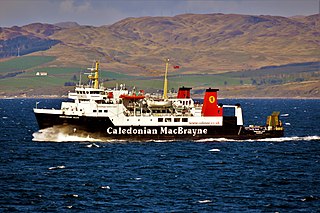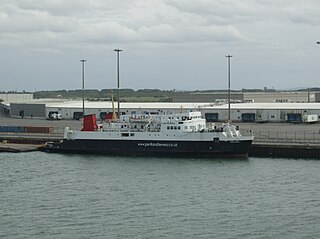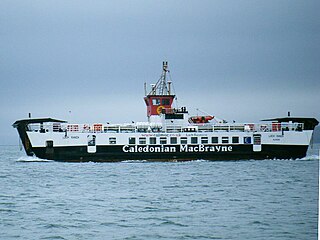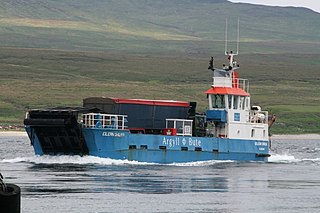
Argyll, sometimes called Argyllshire, is a historic county and registration county of western Scotland.

Western Ferries (Clyde) Ltd is a private ferry company with its headquarters in Hunters Quay, Scotland. It currently operates on the Firth of Clyde running a year-round, high-frequency vehicle carrying service between Hunters Quay, near Dunoon, and McInroy's Point, on the outskirts of Gourock in Inverclyde.

The Caledonian MacBrayne fleet is the largest fleet of car and passenger ferries in the United Kingdom, with 34 units in operation and another 2 under construction. The company provides lifeline services to 23 islands off the west coast of Scotland, as well as operating routes in the Firth of Clyde.

MV Hebridean Isles is a ro-ro vehicle ferry owned by Caledonian Maritime Assets Limited and operated by Caledonian MacBrayne on the west coast of Scotland. She was the first MacBrayne vessel to be built outside Scotland and the first to be launched sideways. With bow, stern and side ramps, Hebridean Isles is suitable for all the routes served by the large fleet units. After 15 years crossing the Little Minch on the Uig triangle, she now serves Islay.

MV Isle of Arran is a drive-through ferry owned by Caledonian Maritime Assets Limited and operated on the west coast of Scotland by Caledonian MacBrayne. Built in 1983, she served on the Arran service for ten years before being moved to Kennacraig. She returned to her original route in 2012, supplementing MV Caledonian Isles in summer and becoming a relief vessel in winter. In 2013, she started a new pilot route from Ardrossan to Campbeltown, which became a permanent fixture in 2015.

West Loch Tarbert, Argyll is a long and narrow sea loch on the western side of the Kintyre peninsula in Scotland.

MV Pioneer is a stern / side loading ferry built in 1974, in service for 29 years covering nearly all of Caledonian MacBrayne's routes. She now serves the islands of São Tomé and Príncipe in the Gulf of Guinea and was chartered to rescue Liberian refugees.

MV Pentalina-B was a fast and extremely versatile ferry which operated on a variety of Scottish routes. Launched in 1970 as MV Iona, she was the first drive-through roll-on/roll-off ferry built for the David MacBrayne Ltd fleet. She was the first ship in the company's history to have bridge-controlled engines and geared transmission, rather than direct drive. She enjoyed a far-flung career and inaugurated more endloading linkspans than the rest of the fleet put together. Purchased by Pentland Ferries in 1997, she was renamed MV Pentalina-B and operated across the Pentland Firth until the arrival of their new vessel. In 2009, she was sold to a Cape Verde owner.

MV Loch Bhrusda is a Caledonian Maritime Assets Limited water-jet propulsion ro-ro car ferry operated by Caledonian MacBrayne. After 11 years operating in the Outer Hebrides, she is now a Clyde-based relief small vessel.

MV Loch Ranza is a Caledonian Maritime Assets Limited ro-ro car ferry, operated by Caledonian MacBrayne, serving the island of Gigha.

MV Loch Linnhe is a Caledonian Maritime Assets Limited ro-ro car ferry, built in 1986 and operated by Caledonian MacBrayne After over ten years at Largs, she was the summer vessel on the Tobermory–Kilchoan crossing from 1999 to 2017.
MV Lochiel was the Islay mailboat operated by David MacBrayne Ltd from 1939 until 1970. Sinking in West Loch Tarbert in 1960, she was refloated and repaired. She became MacBrayne's last surviving mailboat, seeing out her life as a floating bar in Bristol.

MV Arran was a pioneering Firth of Clyde vehicle ferry introduced by Caledonian Steam Packet Company in 1953. She spent fifteen years on the Upper Clyde crossings, followed by five years at Islay. Initially hoist-loading, via side ramps, these were replaced by a stern ramp in 1973. During her final years with CalMac, she relieved across the network. Several unsuccessful attempts were made to turn her into a floating restaurant, before she was scrapped in 1993.

The Sound of Islay is a narrow strait between the islands of Islay and Jura off the west coast of Scotland. It is about 30 kilometres in extent from north to south and lies between Rubh' a' Mhàil on Islay and Rubh' Aird na Sgitheich on Jura to the north and Macarthur's Head and Rubha na Tràille to the south. The islands in the Sound are Am Fraoch Eilean, Brosdale Island and Glas Eilean, all of which are off the south east coast of Jura. These islands, Jura south of Loch Tarbert and the eastern part of the Sound are one of 40 National Scenic Areas in Scotland.

Caledonian Maritime Assets Limited owns the ferries, ports, harbours and infrastructure for the ferry services serving the west coast of Scotland, the Firth of Clyde and the Northern Isles.

MV Eilean Dhiura is a vehicle ferry operating across the Sound of Islay.

MV Rhum is a car ferry built for Caledonian MacBrayne in 1974. Until 1987, she operated the seasonal Lochranza crossing to Arran. Since 1998, she has been one of the Arranmore ferries in County Donegal.
MV Sound of Islay was the first ro-ro ferry on the west coast of Scotland. Built for Western Ferries in 1968, she served Islay and later Campbeltown – Red Bay. In 1981, she was sold to the Government of Newfoundland and Labrador and still operates in eastern Canada.

MV Sound of Jura was the first drive-through car ferry on the west coast of Scotland. She was operated by Western Ferries on the Islay service from Kennacraig between 1969 and 1976. The Mexican Government operated her to Cozumel as Quintana Roo until 2005, when she was wrecked by Hurricane Wilma.

















